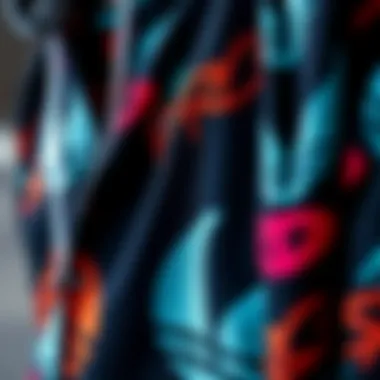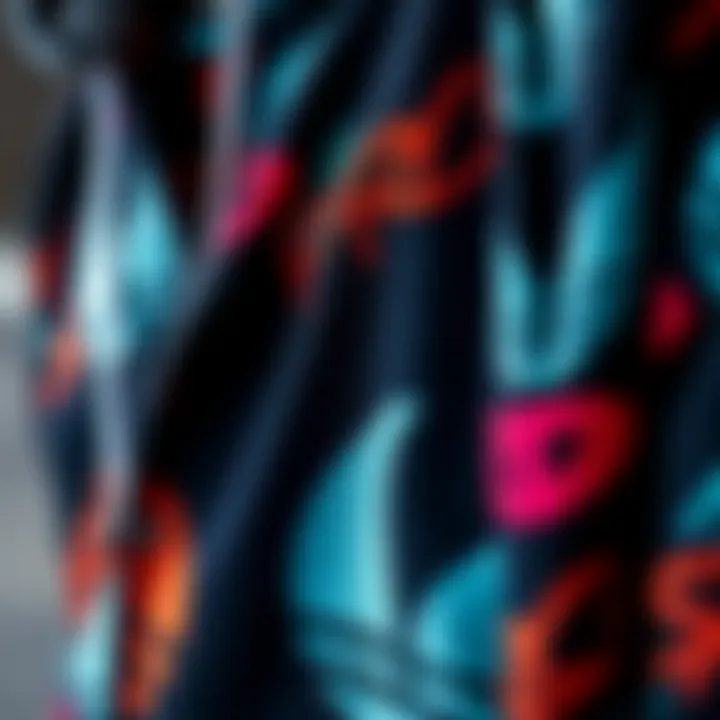The Intersection of Urban ID Clothing and Skate Culture


Intro
The streets are alive with a rhythm that echoes through the wheels of skateboards, pulsating with the stories of those who ride them. Urban ID clothing is not merely about fabric or fashion; it's a canvas that reflects the vibrant culture of skateboarding. In an age where self-expression runs deep, what one wears speaks volumes about identity, attitude, and tribal affiliations in the bustling cities. This article takes a closer look at the essence of Urban ID clothing within skate culture, tracing its roots and exploring its ongoing evolution against a backdrop of artistic designs and societal shifts.
As we navigate through its origins and cultural implications, it becomes clear that Urban ID clothing serves as a form of identity for skaters across the globe. The blend of streetwear aesthetics intertwined with skateboarding has given rise to a unique style that resonates with themes of rebellion, innovation, and community. Today, it’s more than just a trend; it’s an essential element of the skateboarder’s lifestyle.
From the basics that a novice might don to the more elaborate fits for seasoned riders, Urban ID clothing encapsulates the essence of skate culture. Incorporating elements such as comfort, functionality, and statement-making designs is what sets it apart in the crowded realm of fashion. The next sections will dissect the fundamental techniques and tricks of skateboarding while highlighting the vital role of gear and equipment, which serves as an extension of one's identity on the board.
Techniques and Tricks
Understanding the practical aspects of skateboarding is essential for both the rookie and the seasoned rider. Skills on the board go hand in hand with personal style, as they often define how one connects with the Urban ID clothing they choose to wear. Here, we will delve into the skating techniques that complement one’s style:
Basic Tricks for Beginners
For those just starting out, grasping the fundamentals is a rite of passage. Basic tricks form the foundation upon which skaters build their repertoire. Here are a few essential tricks:
- Ollie: A must-know trick that involves popping the tail of the skateboard while simultaneously jumping, allowing the rider to gain height.
- Push: The simplest yet crucial technique that involves propelling the board forward with one foot, a fundamental skill for navigating the streets.
- Kickflip: A natural progression from the ollie, this trick involves flipping the board in the air. Though tricky, it’s a staple in every skater's toolkit.
Advanced Techniques for Pro Skaters
Once the basics are mastered, skaters advance to more dynamic techniques that not only show off skill but also enhance personal expression through style. While wearing meticulously chosen Urban ID clothing, pros can pull off these impressive moves:
- Heelflip: Similar to the kickflip, but involves pushing the board flicked by the heel.
- Smith Grind: A staple in street skating involves grinding on the rear axle while the front of the board leans off the rail or edge.
- 360 Flip: A twist on the classic flip, this trick encompasses a 360-degree spin of the board while simultaneously flipping it.
Skateboarding is much more than just a series of tricks; it is an art form that merges physical skill with personal style and identity. Tapping into these techniques while donning Urban ID clothing empowers skaters to express themselves authentically.
Gear and Equipment
A skateboarder’s choice of gear is essential, acting not only as functional equipment but also as a reflection of individual style. Urban ID clothing often complements the essentials that every skater should consider:
Essential Skateboarding Gear
- Skateboard: The heart and soul of the sport, selecting the right board can determine how one skates. Size, shape, and material matter.
- Safety Gear: Helmets and knee pads are non-negotiable for both new and experienced skateboarders. Protecting oneself should always be a priority.
- Footwear: Shoes designed for skating offer traction and support. Brands like Vans or Nike SB are popular for a reason, as they fuse style with function.
Latest Trends in Skate Gear
If you think every piece of skate gear looks the same, think again. Urban ID clothing is so intertwined with advanced gear that it’s hard to separate them. Some trends worth noting:
- Eco-friendly Materials: As environmental consciousness grows, brands that utilize sustainable materials in their manufacturing are gaining traction.
- Bold Patterns and Graphics: Bright colors and artistic designs are becoming the norm, allowing skaters to showcase their personality.
- Versatile Clothing: Attire that transitions from skating to everyday wear is increasingly sought after, offering flexibility without sacrificing style.
Urban ID clothing and skate culture are not just related; they are fundamentally intertwined, reflecting deeper social narratives and personal journeys.
In summary, Urban ID clothing embodies the spirit of skateboarding, merging functionality with self-expression. The ongoing evolution of styles and techniques underscores a vibrant community that continues to inspire and push boundaries. Readers can expect to engage deeply with this culture, as we weave through its past, present, and future.
Preface to Urban Clothing
Urban ID clothing emerges as a defining element within the realm of skate culture, capturing the essence of urban life, individuality, and, of course, the spirit of skateboarding. This section aims to lay the foundation for a deeper understanding of what Urban ID clothing truly signifies, both as a fashion statement and as an aspect of identity. The relevance of Urban ID clothing in the skateboarding community cannot be overstated. It reflects a unique blend of style, functionality, and cultural significance that resonates with skateboarders and enthusiasts alike.
Defining Urban Clothing
Urban ID clothing goes beyond what one might casually refer to as streetwear. It encapsulates a style forged in the crucible of urban environments, where art, music, and lifestyle coalesce. Typically, Urban ID clothing comprises garments that are not just made for comfort during skating but also express individuality and brand identity through graphics, logos, and distinctive designs. Think of that oversized hoodie you might see a skater wearing, adorned with bold artwork that shouts their beliefs or references cultural elements.
Words like "skate-inspired" or "urban aesthetics" often float around in the discussions of this fashion genre, but how do we categorize it? At its core, Urban ID clothing speaks to a lived experience — a source of pride for those who wear it. The choice of materials, cut, and style are not mere coincidences; they mirror the lifestyle of the urban skateboard community. A pair of baggy shorts or a graphic t-shirt isn’t simply a clothing choice — it tells a story, proclaiming where one belongs.
Historical Context and Evolution
To fully grasp Urban ID clothing, one must consider its historical trajectory. It didn't just spring into existence overnight. The roots of this style trace back to the evolution of skate culture in the late 20th century. In the 1970s and 80s, skateboarding transitioned from a niche hobby to a more mainstream acceptation, birthing brands like Vans and Thrasher that would lay the groundwork for Urban ID fashion.
This era marked the beginning of a unique relationship between music, art, and skateboarding — a triad that surfed the waves of urban chaos and creativity. Graphic tees often sported iconic images or logos that resonated with the youth, acting as badges of identity. As skate culture burgeoned, so did the representation of its members through their clothing choices, distinguishing them from the masses.


As time marched on, the 90s and 2000s ushered in more diverse influences from hip-hop and punk rock, further evolving Urban ID clothing. Now, you can find echoes of these predecessors in contemporary designs, where bold graphics meet sustainable materials. The evolution continues, as new styles and trends emerge, seeking to define what skate fashion looks like today and tomorrow.
Cultural Significance of Urban Clothing
Urban ID clothing isn’t just a trend; it's a rich tapestry woven from the threads of culture, identity, and rebellion in urban settings. Skate culture, in particular, has adopted this style not merely as a fashion statement but as an emblem of lifestyle and communal belonging. The significance goes beyond the superficial; it offers insights into the way the skateboard community navigates societal norms and expresses individuality. This article dives deeper into how urban ID clothing acts as a canvas for these expressions, reflecting the lived experiences of those involved.
Streetwear Influence on Skate Culture
To understand the connection between streetwear and skate culture, one must first appreciate their shared roots. Emerging from the vibrant streets of cities like Los Angeles and New York, both cultures promote creativity and self-expression. Streetwear, with its oversized fits, bold graphics, and quickly changing trends, serves as an ideal companion to the skateboarding ethos of freedom and defiance.
This blend manifests in several ways:
- Graphic Designs: Skate brands frequently collaborate with visual artists, incorporating unique illustrations that resonate with the skater lifestyle. Pieces from brands like Baker and Element showcase both artistic flair and functional wear.
- Inclusivity and Diversity: Skateboard culture has opened the doors for various influences, expanding the definition of style. Streetwear has made it possible for skaters of all backgrounds to find attire that represents them.
- Limited Drops and Exclusivity: The practice of releasing limited edition clothing not only drives demand but also cultivates a sense of community among skaters who eagerly await their chance to snag the latest piece.
In this way, streetwear transcends mere fashion; it evolves as a form of cultural dialogue within the skate culture.
Symbolism and Identity Representation
Urban ID clothing carries layers of meaning for its wearers. For a skater, the choice of attire often symbolizes one's commitment to the culture, aspirations, and social circles. It does not merely signify participation; it announces identity within a broader community.
Consider these dimensions:
- Cultural Signifiers: Clothing often reflects affiliations with specific skate brands or subcultures. For instance, wearing a Thrasher hoodie signifies more than comfort; it's a nod to the skateboard community's rebellious spirit.
- Expression of Values: Logos and slogans on urban ID clothing can embody values such as authenticity, anti-establishment views, and self-determination. These visual cues unite individuals with similar outlooks.
- Connection with Place: Many skaters choose gear that showcases local artists or brands, fostering a sense of pride and anchoring their identity to a specific locale. This can spark conversations and camaraderie among skaters from different regions.
This symbolism is crucial, as it highlights the significance of how people navigate their identities through clothing choices, shaping perceptions both within and beyond the skate community.
Fashion as a Form of Resistance
Throughout history, fashion has served as a medium of resistance and rebellion, and urban ID clothing is no exception. Particularly in skate culture, where many feel marginalized or misunderstood, clothing becomes a statement against societal expectations.
Here’s how urban ID clothing embodies this resistance:
- Authenticity: Skaters who wear urban ID clothing make a deliberate choice to present their authentic selves, often challenging conventional beauty standards or consumerism. This defiance resonates deeply in a culture that values individuality over conformity.
- Challenges to Mainstream Culture: Through bold graphics and messages, skaters can comment on societal issues such as commercialization and gentrification. These narratives often reveal deep-seated frustrations and hopes for change, turning the skate park into a platform for social commentary.
- Community Solidarity: Fashion connects individuals within a subculture, fostering solidarity in a world that often marginalizes them. Wearing the same brands can signify loyalty and understanding among skaters, reinforcing a shared identity.
Urban ID clothing, thus, becomes more than a choice of what to wear; it evolves into a lifeline for connection and a shield against societal pressures.
"Fashion within skate culture is not just about style; it’s a profound language of who we are and where we stand in society."
Key Elements of Urban Clothing Design
Urban ID clothing carries more weight than just aesthetic appeal; it embodies the ethos of skate culture and speaks to concerns in contemporary life. Understanding the key elements of its design helps unravel why urban ID has become a mainstay among skateboarders and fashion enthusiasts alike. Each element, be it graphic design or the materials used, forms a part of a larger narrative that defines this style. Let's dive into the unique aspects that characterize urban ID clothing.
Influence of Graphic Design and Artwork
Graphic design plays a pivotal role in urban ID clothing. One might argue that it's the heartbeat of this fashion movement. Bold graphics, intricate illustrations, and vibrant colors not only attract attention but also convey messages. For instance, the graphics often reflect the struggles and triumphs of street life, a theme resonating deeply with skateboard culture.
Many brands collaborate with local artists to ensure that their designs capture authenticity. Take the example of Supreme; their designs often showcase artwork that represents the skate community's values and experiences. These graphics can evoke emotions, from joy to defiance, and serve as conversation starters among fellow skaters. It’s like wearing a piece of art that tells a story.
Moreover, seasonal collections often introduce fresh graphic insights, shifting with societal changes.
Materials and Sustainability
The materials chosen for urban ID clothing are equally significant. As the world increasingly leans towards sustainability, the skate community is no exception. Fabrics like organic cotton, recycled polyester, and even hemp are making headway into the core of urban ID clothing design. The switch isn't just for trends; it demonstrates a commitment to reducing the environmental impact, something that resonates with many younger consumers.
Skateboarding places heavy demands on attire, so durability is a primary focus. Brands favor thicker fabrics that withstand wear and tear, but with the new green wave, many are finding ways to source sustainable options without compromising on durability. Companies like Patagonia exemplify brands weaving sustainability into their framework while delivering products that last.
Comfort vs. Style: The Balancing Act
Finding the balance between comfort and style is no easy feat in urban ID clothing, yet this tension often leads to innovation. Skateboarding is physically demanding, requiring clothing that allows for flexible movement. Loose-fitting shirts, baggy pants, and breathable materials are staples that provide that ease. However, this does not mean sacrificing style.


The challenge lies in merging high functionality with eye-catching designs. Streetwear must appeal to the aesthetic demands of its consumers while also holding up against the rigors of daily skateboarding. Many brands achieve this by incorporating functional elements—such as hidden pockets or moisture-wicking materials—into stylish designs. In essence, skateboarders want to look good while they perform at their best.
Market Trends in Urban Clothing
Understanding market trends within urban ID clothing is like spotting the flick of a skateboarder making a turn; the nuances matter. The landscape of urban fashion is in constant flux, shaped by the tight-knit community of skateboarders and the larger influences of street culture. Whether it’s the materials used or the creative collaborations that take flight, it's crucial to comprehend how these elements contribute to the status of urban ID clothing today.
Rise of Influencer Collaborations
Influencer collaborations have paved a new path for urban ID clothing, flipping the script on traditional marketing strategies. Influencers have the power to shape public perception and consumer choices. Instead of relying solely on ads, brands now partner with skate influencers to leverage their authenticity and reach.
For instance, consider how renowned skateboarders like Nyjah Huston collaborate with leading brands. When they showcase a new line, their followers—who are often skateboarders or enthusiasts—are more likely to invest in apparel they see associated with their favorite athletes. This synergy boosts the appeal and credibility of urban ID clothing even further.
"Collaboration serves as a bridge; it connects brands with the heart and soul of skate culture, creating a deeper resonance with consumers."
The benefit of such partnerships goes beyond mere visibility. They allow brands to align their image with those who are living embodiments of skate culture, translating to higher sales and brand loyalty across demographics, particularly among young adults seeking authenticity and connection.
The Role of Social Media in Fashion Trends
Social media is the beating heart of urban ID clothing trends. Platforms like Instagram, TikTok, and Pinterest provide a canvas for urban wear aesthetics, where styles can go viral overnight. Skateboarding videos intermingle with fashion posts, creating a rich tapestry of content that inspires countless viewers.
Trends can be born in skate parks and quickly spread through hashtags or challenges. When a skate video featuring a unique outfit trend emerges, it can ignite widespread interest. The interplay between skate culture and fashion is tangible; skaters wore what they liked, and now that sentiment fuels fashion movements, bending traditional norms.
- Visual storytelling: Posting photos or videos of streetwear outfits can inspire others to adopt similar styles.
- Hashtags: Trends like #Streetwear or #SkateFashion allow brands to tap into these discussions directly.
Thus, social media not only facilitates communication but shapes tastes, making it an indispensable tool for brands wanting to stay ahead in the urban ID clothing market.
Consumer Trends Shaping the Market
As much as brands influence trends, consumer behavior shapes the market just as significantly. Urban ID clothing is no longer just about looking good; it's about personal expression and alignment with larger ideals. Today's consumers are conscious of sustainability, ethical practices, and cultural representation.
- Sustainable Choices: Many consumers prioritize brands that focus on environmentally friendly materials and production processes. Skate culture is generally perceived as down-to-earth and connected to community ethics, so eco-friendly practices resonate well.
- Cultural Authenticity: Many are searching for authenticity in brands; they want to feel a connection to the roots of skate culture. Products that reflect genuine street styles and narratives are more likely to entice buyers.
Changing preferences coupled with the demand for purpose-driven fashion means that brands must navigate the market carefully. They need to be aware and responsive to consumers, blending creativity with meaningful practices.
With these trends afoot—where influencer power, social media resonance, and consumer awareness intertwine—urban ID clothing continues to morph, reflecting the very essence of skate culture. As this article unfolds, it will delve deeper into these dynamics, shedding light on the future of urban apparel.
Local vs. Global Perspectives
The intersection of local and global perspectives in urban ID clothing stands as a vital thread in understanding the vast landscape of skate culture. As this style continues to evolve, the importance of recognizing both regional influences and global trends cannot be understated. Urban ID clothing serves not just as a personal expression but as a cultural artifact that mirrors the nuances of urban life across different geographies while simultaneously engaging with global phenomena.
Local styles reflect the unique cultural realities of specific communities. For instance, the vibrant, graffiti-inspired designs of urban ID clothing in regions like Philadelphia often carry a different vibe compared to the minimalist aesthetics seen in Scandinavian countries. This regional variation not only influences how clothing is designed but also how it is perceived by local communities.
Understanding these regional nuances helps in appreciating the historical and cultural contexts from which skate culture and urban ID clothing arise. While skateboarding and its associated fashion may originate from a shared subculture, local resources, societal values, and environmental factors shape the designs and attitudes surrounding urban ID clothing.
Conversely, global brands play an essential role in knitting together varied local expressions. They do this by amplifying local styles and culture on a worldwide stage. These brands harness the power of social media and e-commerce, making it easier for global audiences to access diverse urban ID fashion. This interconnectedness means that while local skaters may don distinctly regional styles, they can also express themselves through globally recognized brands that resonate with their urban identity. Local creators aren't just competing; they’re often collaborating with larger companies, further blending the lines between the local and global.
"Urban ID clothing is the convergence of personal expressions shaped by local environments yet disseminated through global platforms."
Key Benefits of Understanding Local vs. Global Perspectives
- Cultural Awareness: Insight into how local adaptations can challenge or conform to global trends helps foster a more inclusive understanding of skate culture.
- Market Dynamics: Recognizing brand collaborations with local artists leaves room for niche markets to grow while respecting traditional aesthetics.
- Consumer Choice: Enhanced appreciation of the variety available to skateboarders, from niche local brands to larger global names.
Considerations for Local vs. Global Perspectives
- Authenticity: How do brands retain authentic local character when trying to reach a global audience?
- Cultural Appropriation: Brands must tread carefully to ensure they respect the local cultures they draw from without commodifying them.
- Sustainability: The global versus local debate extends to production techniques and materials used in urban ID clothing. Understanding the impact of local sourcing versus global supply chains is essential for conscious consumers.
In summary, the dialogue between local and global perspectives enriches our understanding of urban ID clothing within skate culture. It allows for a more layered conversation about identity, authenticity, and community, emphasizing that while skate culture may be rooted in locality, it is also very much a global phenomenon.
Impact of Technology on Urban Clothing


In the contemporary landscape of fashion, technology plays a pivotal role in shaping various sectors, and the realm of Urban ID clothing is no exception. For skateboarders and fashion enthusiasts alike, technology has become the thread that stitches together myriad styles and identities, all while reinforcing the ethos of skate culture. The convergence of fashion and technology has not only affected the aesthetic components but has also revolutionized marketing tactics and consumer interaction.
E-commerce Trends and Digital Marketing
The digital age has ushered in an era where physical storefronts are no longer the sole purveyors of style. Online shopping has ballooned, allowing for immediate access to Urban ID clothing. Skate brands such as Supreme and Thrasher utilize platforms like Shopify and Instagram to break down geographical barriers, giving skate enthusiasts from Tokyo to Paris a taste of hard-to-find gear.
- The rise of direct-to-consumer models means that brands can engage directly with their customers, collecting feedback and insights that influence future collections.
- The use of social media platforms allows for real-time marketing strategies, where brands can respond to trends almost instantaneously, catering to the ever-evolving landscape of skate fashion.
- Influencer collaborations, often seen across various social media platforms, keep Urban ID brands in the limelight, melding community voices with brand narratives.
Moreover, data-driven strategies allow brands to analyze consumer behaviors effectively, helping them create more personalized shopping experiences. By employing algorithms, retailers can recommend items based on previous purchases or browsing context, ensuring that visitors encounter clothes that resonate with their unique styles. With the click of a button, skateboarders can scout for the latest Urban ID trends, often leading to a rapid shift in consumer preferences.
Wearable Technology and Fashion Innovation
The integration of wearable technology within Urban ID clothing hints at a future where style and functionality coexist seamlessly. Smart fabrics, for example, can regulate body temperature or provide hydration, serving purposes beyond aesthetics. This innovation isn’t merely for tech enthusiasts; it’s carving a niche in the skate community as brands aspire to fuse tech with relevant urban culture.
The notion of fashion innovation through technology extends into the design process itself. Brands like Nike and Adidas have pioneered the use of 3D printing to create bespoke footwear tailored for skateboarders’ unique needs, ensuring comfort and style without compromising performance.
Additionally, concepts such as augmented reality (AR) allow customers to try on clothing items virtually, elevating their shopping experience. A skateboarder can see how a hoodie fits before making that purchase, eliminating guesswork and reducing returns—a significant win for both brands and buyers alike.
"The future of Urban ID clothing lies not just in what we wear, but in how we interact with it. Tech is bridging the gap between culture and functionality like never before."
For further reading on trends in e-commerce, visit Wikipedia's E-commerce Overview.
For insights into how technology influences fashion trends, check out Britannica on Fashion Technology.
Also, feel free to explore practical discussions on reddit regarding Tech and Fashion for community experiences and insights.
Future of Urban Clothing
The future of Urban ID clothing stands at a crossroad, where tradition meets innovation, and the pulses of street culture continuously shape its evolution. As society changes, so too does the fabric of urban fashion, especially within the skateboarding community. Understanding the pathway ahead is crucial for all stakeholders, from avid skaters to aspiring brands and market analysts.
The interplay between function and fashion will be at the forefront. Brands are more aware than ever that style must blend seamlessly with performance. As skateboarding pushes the boundaries of athletic wear, expect a rise in garments that incorporate advanced materials yet retain the bold aesthetics that define urban style. The fabric may not just be durable; it could be breathable, moisture-wicking, and in some cases, even responsive to temperature. For instance, skate brands like Supreme and Palace have already started exploring smart textiles, paving the way for broader acceptance across the market.
Predictions for Coming Trends
The trends expected to emerge within Urban ID clothing nod towards sustainability, technology, and cultural heritage.
- Sustainable Materials: Expect eco-friendly fabrics to surge in popularity. Brands might shift from synthetic fibers to organic and recycled materials, fulfilling a growing consumer demand for sustainable fashion.
- Cultural Acknowledgment: Urban clothing will likely draw even deeper from local cultures and traditions, with unique patterns and designs that pay homage to diverse communities. This trend aligns closely with the growing appreciation for authenticity in clothing.
- Project Outfits: Customizable clothing could become more mainstream, allowing skaters to personalize their attire based on individual style or local skate scenes.
"Fashion isn't just about clothes; it's about the stories they tell and the identities they build."
The fusion of innovation and cultural appreciation paints a compelling future for the Urban ID clothing landscape, particularly in the vivacious skate community.
Potential Shifts in Consumer Attitudes
The mindset of consumers is evolving, and as a result, so is their relationship with Urban ID clothing. Today's consumers are discerning and savvy. They seek not only aesthetic appeal but also authenticity and connection.
- Value Beyond Appearance: Expect skaters and streetwear enthusiasts to place greater importance on the story behind the clothes. Purchasing decisions may increasingly hinge on a brand's sustainability initiatives or community involvement.
- Embracing Diversity: There’s an undeniable shift towards celebrating differences in styles, sizes, and gender expressions. As skate culture evolves, so will the definitions of who can wear what, encouraging brands to broaden their target audiences.
- Community Engagement: Consumers will likely seek brands that resonate with their values, opting for those whose marketing engages genuine community perspectives rather than just hype.
In summary, as Urban ID clothing continues to permeate the skate culture, its trajectory will be influenced significantly by sustainability, technological advancements, cultural authenticity, and shifts in consumer attitudes. It’s a thrilling time for both creators and consumers alike.
Closure
Reflecting on the role of Urban ID clothing encapsulates more than just fashion; it’s a lens through which the vibrancy and challenges of urban life are perceived. This article delves into the nuanced layers that make up Urban ID clothing and its intrinsic connection to skate culture. By illustrating the backdrop against which this clothing thrives, we can better appreciate its significance within various urban environments.
Reflecting on Urban Clothing's Influence
The influence of Urban ID clothing on both skate culture and broader social dynamics cannot be overstated. It is a tapestry woven with threads of diversity, creativity, and self-expression. Skateboarding, often viewed as a subculture, uses Urban ID clothing not merely as apparel but as a vehicle for personal narrative and communal identity.
- Cultural Significance
- Community Building
- Economic Impact
- Urban ID clothing often tells a story of rebellion and discontent, providing voice to the marginalized. The graphics and designs reflect the urban landscapes—from graffiti to street art—that inform the aesthetic.
- Through brand loyalty and collaborative projects, such as those between local artists and emerging clothing lines, skate culture fosters a sense of unity among enthusiasts. This resonates especially with young skateboarders who find in Urban ID clothing a means of self-identification and camaraderie.
- The rise of Urban ID clothing has propelled the skateboarding market by creating job opportunities, from designers to retailers. Skate shops often curate local Urban ID clothing alongside globally recognized names, bridging local cultures with worldwide trends.
Ultimately, Urban ID clothing holds a mirror to the essence of skate culture—it's about connections, identity, and moving against the grain. It allows individuals to not only dress a certain way but to express who they are and where they come from. As we move into a future that embraces individuality, the importance of these clothing narratives in skate culture will likely continue to spur discussions and inspire new movements.



